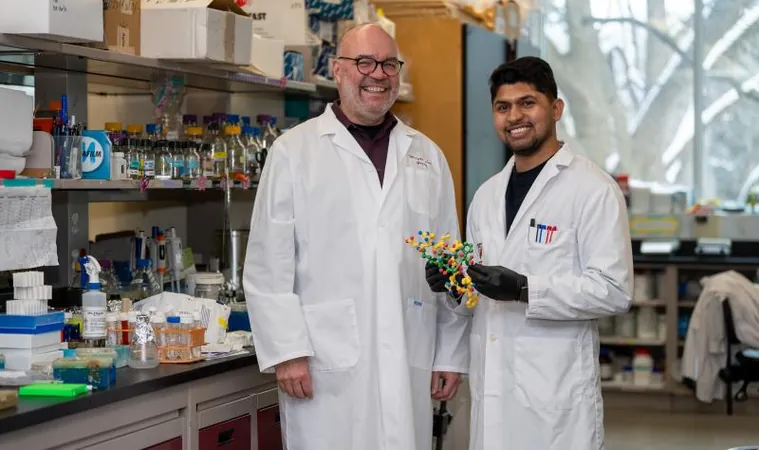
Groundbreaking Discovery: A New Antibiotic Compound Unearthed from Soil!
2025-03-31
Author: Benjamin
In an era marked by alarming rates of antibiotic resistance, researchers from Canada and the United States have made an exciting breakthrough that could pave the way for an entirely new class of antibiotics. This discovery comes at a crucial time when the antibiotic pipeline is critically low, igniting hopes of a future where we can effectively combat multidrug-resistant infections.
The research team, comprising scientists from McMaster University in Ontario and the University of Illinois at Chicago (UIC), has revealed an antibiotic peptide named lariocidin. This remarkable compound was identified in soil bacteria that had been cultivated for a year in a laboratory setting. Initially, scientists observed that a substance produced by one of the soil bacteria exhibited significant antibacterial activity against some of the toughest bacterial strains known to resist multiple drugs. Through meticulous investigation, they confirmed lariocidin as the source of this potent activity.
What sets lariocidin apart from existing antibiotics is its unique lasso-like chemical structure and distinct mechanism of action. Extensive tests have shown that lariocidin is effective against a broad range of bacteria without being toxic to human cells, and it has also demonstrated efficacy in animal models of infection. These promising findings were published recently in the prestigious journal Nature.
Dr. Gerry Wright, who leads the Michael G. DeGroote Institute for Infectious Disease Research at McMaster, expressed his enthusiasm about the findings, stating, "This is exactly where you want to be at the beginning of this journey. Now to see whether or not we can turn it into a drug."
The quest for new antibiotics has been challenging. Wright and his team have dedicated years to searching for naturally occurring antibiotic compounds in environmental microbes. They have collected an impressive array of 13,000 microbial samples, hoping to uncover not just resistance genes, but also antimicrobial agents. Historically, the environment has been a rich source for antibiotics—think penicillin from mold, or daptomycin from Turkish soil—yet pharmaceutical companies have largely turned their backs on these natural sources since the 1980s, deeming them less lucrative.
Wright's approach involved growing microbes from soil collected from a team member's backyard, which led to the identification of the potent bacterium Paenibacillus. While many fast-growing bacteria perished, this slower-growing species produced an extract that revealed remarkable antibacterial properties against pathogens like Escherichia coli and Acinetobacter baumannii, notorious for their drug resistance.
Initially, researchers suspected that the effectiveness was due to colistin, an older antibiotic produced by Paenibacillus. However, using advanced techniques, they isolated lariocidin as a novel antibacterial molecule—one that could have been overlooked under conventional testing methods.
Further investigations into the mode of action of lariocidin revealed that it binds to a different site on the bacterial ribosome, setting it apart from other types of antibiotics. This unique binding site makes it less vulnerable to the common resistance mechanisms bacteria employ against existing drugs.
As they expand their research, the team is also exploring a promising variant, lariocidin B, which may showcase even greater therapeutic potential. However, Wright acknowledges the long and arduous journey ahead, involving the transition from a natural product to a viable clinical treatment. This process entails reconstructing the peptide to enhance antibacterial activity and determining the pharmacological properties necessary for human testing.
Funding remains a significant hurdle, as the pharmaceutical industry is not currently prioritizing antibiotic discovery—a stark reality in the field. Nonetheless, Wright is optimistic about ongoing collaborative efforts between Canadian and U.S. research teams, bolstered by governmental support, which he believes can foster further discoveries in the fight against antibiotic resistance.
"This is a good-news story," said Wright. "If we work together, we can do great things!" The potential of lariocidin represents not just a scientific milestone, but a beacon of hope in our battle against resistant infections, urging us to rally around antibiotic discovery even when the odds seem insurmountable. Stay tuned for more updates as this exciting story unfolds!









 Brasil (PT)
Brasil (PT)
 Canada (EN)
Canada (EN)
 Chile (ES)
Chile (ES)
 Česko (CS)
Česko (CS)
 대한민국 (KO)
대한민국 (KO)
 España (ES)
España (ES)
 France (FR)
France (FR)
 Hong Kong (EN)
Hong Kong (EN)
 Italia (IT)
Italia (IT)
 日本 (JA)
日本 (JA)
 Magyarország (HU)
Magyarország (HU)
 Norge (NO)
Norge (NO)
 Polska (PL)
Polska (PL)
 Schweiz (DE)
Schweiz (DE)
 Singapore (EN)
Singapore (EN)
 Sverige (SV)
Sverige (SV)
 Suomi (FI)
Suomi (FI)
 Türkiye (TR)
Türkiye (TR)
 الإمارات العربية المتحدة (AR)
الإمارات العربية المتحدة (AR)